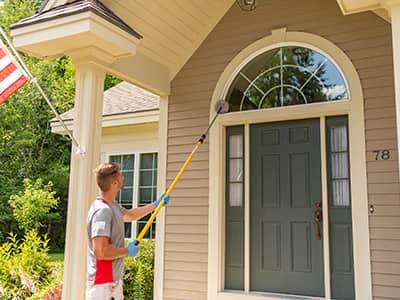What types of wasps are commonly found in Maine?
There are many species of wasps; three of the most commonly found wasps in Maine include yellow jackets, paper wasps, and hornets.
What do wasps look like?

Yellow Jackets
Adult worker yellow jackets grow to be between 3/8th and 5/8th of an inch in length; queens are larger. They have a black and yellow body that usually forms a band-like pattern. They have six legs, antennae, and their wings are folded lengthwise along their body when they are at rest.

Paper wasps
Adult paper wasps are 5/8 to ¾ of an inch in length. They are brown and, depending on the specific species, may have yellow or red markings. They have antennae, a pinched waist, and 6 long thin legs.

Bald-faced hornets
Though called hornets, bald-faced hornets are actually members of the wasp family. Adult workers grow up to ¾ of an inch in length. Queens are ¾ of an inch or larger in size. They are mostly black and have a unique white pattern that covers their face.
When is wasp season in Maine?
Wasp season in Maine typically begins in the spring as the weather warms up and continues throughout the summer and into early fall. While the exact timing varies depending on weather and species, it's important to note that wasps become more of a problem in late summer and early fall.
Where do wasps nest?
Wasps can nest in a variety of locations, depending on the species. While some build aerial nests in trees, under roof eaves, and shrubs, others nest in the ground. Common places to find wasps nests include, but are not limited to:
- Trees
- Bushes and shrubs
- Empty rodent burrow
- Roof eaves
- Attics
- Chimneys
- Wall cavities
Are wasps dangerous?
Although some wasps, such as yellow jackets, are more aggressive than others, all wasps should be considered dangerous. If these stinging insects build nests in your home or near an entrance of your home, there's an increased risk of being stung. That's because wasps will defend their nest by stinging anyone or anything that comes too close. What's more, wasps will also sting if they feel threatened.
The venom from a wasp sting is strong enough to cause an allergic reaction, in some cases, a severe allergic reaction that requires immediate medical attention. For most individuals though, wasp stings are uncomfortable and may cause redness, swelling, and tenderness at the sting site.
What should I do if I get stung by a wasp?
If you get stung by a wasp and are not experiencing an allergic reaction, clean the affected area with soap and water and apply a cold compress to reduce swelling. Over-the-counter pain relievers and antihistamines can help alleviate pain and allergic reactions.
If you experience severe symptoms or an allergic reaction, seek medical attention immediately.
What should I do if I discover a wasp nest on my property?
If wasps have built a nest in or near your home the best way to control them is through the help of a professional wasp control expert. Attempting to remove a nest on your own has the potential to be dangerous and ineffective.
At Pine State Pest Solutions, we have the tools, safety equipment and knowledge to control wasps. Contact us today to find out more about our stinging insect solutions.
Ongoing home pest control services that target wasps & other pests
Home Protection
Starting as low as $35/month*

Pine State’s Home Protection is an affordable pest control plan that is ideal for homeowners who want general pest control services that target common house-infesting insects and rodents.
When you sign up for this ongoing service, you’ll receive an initial service visit to treat the existing pest problem and then seasonal service visits spread out over the year to ensure pests stay out. That’s a total of four services annually.
Pests covered under Pine State’s Home Protection plan include carpenter ants, cornfield ants, crazy ants, field ants, little black ants, pavement ants, Asian lady beetles, carpet beetles, cigarette beetles, drugstore beetles, flour beetles, ground beetles, hide beetles, larder beetles, saw-toothed grain beetles, warehouse beetles, boxelder bugs, carpenter bees, centipedes, clover mites, American cockroaches, brown-banded cockroaches, wood cockroaches, field crickets, house crickets, European earwigs, firebrats, bald-faced hornets, European hornets, deer mice, house mice, millipedes, Angoumois grain moths, drain moths, Indian meal moths, Mediterranean flour moths, mud daubers, Norway rats, paper wasps, pill bugs, rice weevils, silverfish, sow bugs, springtails, cellar spiders, daddy longlegs spiders, house spiders, jumping spiders, sac spiders, wolf spiders, Western conifer seed bugs, and yellow jackets.
*Some exclusions apply- please see your agreement
Wasp prevention tips
Since you really can’t stop wasps from foraging on your property, you should focus your prevention efforts on making your home a fortress that they cannot penetrate.
- Seal gaps and openings
- Repair holes in soffits
- Address other areas where these stinging insects may access
In late summer and early fall when their numbers have increased dramatically, stinging insects will start to looking for food sources that could include sugary sodas, fruits and other staples at a BBQ or picnic. To prevent your outdoor activities from being disrupted, we recommend keeping food covered and to throw away empty soda cans and pick up trash right away.
